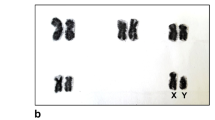Abstract
In this report the karyotypes of 54 species of the tribe Milesiini and of four species of the tribe Myoleptini are described in detail with illustrations and idiograms. These species belong in the genera Lejota, Myolepta, Blera, Calliprobola, Criorhina, Hadromyia, Milesia, Somula, Sphecomyia, Spilomyia, Syritta, Temnostoma, Tropidia and Xylota. Six species have 2n = 8 chromosomes, 35 have 2n = 10 (including Xylota nemorum which has about 20 extra microchromosomes in some specimens), 15 have 2n = 12, one has 2n = 14, and Somula decora has 2n = 10 large chromosomes plus about eight microchromosomes. The mean total complement length (TCL) for 347 complements analysed in these tribes was 53.7 μ but there is great variation between TCL's of complements analysed even from a single fly. Karyotypes of species of Myolepta in the Myoleptini resemble in certain respects those of species of Tropidia in the Milesiini. Our observations support Currran's transfer of Lejota cyanea to the Milesiini. The 2n = 12 karyotypes of species of Blera, Criorhina, Lejota, Milesia, and to a lesser extent Sphecomyia, have some features in common. Spilomyia species have rather distinct 2n = 10 karyotypes. Certain species in Calliprobola, Syritta and Hadromyia are karyologically similar to some species of the genus Xylota in which species studied fall into fairly distinct karyological groups. These observations provide clear evidence of the accumulation of karyotypic variations in the origin of species in these two tribes.
Similar content being viewed by others
References
Boyes, J. W.: Somatic chromosomes of syrphid flies. Proc. Intern. Genet. Symp. 1956. Cytologia (Tokyo), Suppl. 347–351 (1957);- Chromosomes in classification of Diptera. Proc. 10th Int. Congr. Entomol. (Montreal 1956) 2, 899–906 (1958); - Somatic chromosomes of syrphid flies. Canad. J. Genet. Cytol. 1, 39–48 (1959).
Boyes, J. W., and Janny M. van Brink: Cytotaxonomy of syrphid flies. In: Genetics today. Proc. XI Int. Cong. Genetics 1, 138 (1963);- Chromosomes of syrphid flies. I. Karyotypic variation. Chromosoma (Berl.) 15, 579–590 (1964); - Chromosomes of calyptrate Diptera. Canad. J. Genet. Cytol. 7, 537–550 (1965); - Chromosomes of Syrphidae. II. Karyotypes of five species in the tribe Sericomyiini. Chromosoma (Berl.) 19, 399–404 (1966).
—, and A. F. Naylor: Somatic chromosomes of higher Diptera. VI. Allosomeautosome length relations in Musca domestica L. Canad. J. Zool. 40, 777–784 (1962).
Coe, R. L.: Diptera. Syrphidae. Handbooks for the identification of British in sects, vol. 12, p. 1–98. London: Roy. entom. Soc. 1953.
Curran, C. H.: New Canadian Diptera with a synopsis of the genus Cynorhina. Canad. Entomol. 56, 193–196 (1924); - The families and genera of North American Diptera. New York: Ballou Press 1934.
Frolowa, S.: Die Polyploidie einiger Gewebe bei Dipteren. Z. Zellforsch. 8, 524–565 (1929).
Glumac, S.: Phylogenetic system of the syrphid-flies (Syrphidae, Diptera) based upon the male genitalia structure and the type of the larvae. Proc. 11th Int. Congr. Entomol. (Vienna) 1, 202–206 (1960).
Goffe, E. R.: An outline of a revised classification of the Syrphidae (Diptera) on phylogenetic lines. Trans. Soc. Brit. Entomol. 11, 97–124 (1952).
Hull, F. M.: The morphology and inter-relationship of the genera of syrphid flies, recent and fossil. Trans. roy. Soc. Lond. 26, 257–408 (1949).
Keuneke, W.: Über die Spermatogenese einiger Dipteren. Z. Zellenu. Gewebelehre 1, 357–412 (1924).
Metz, C. W.: Chromosome studies on the Diptera. II. The paired association of chromosomes in Diptera and its significance. J. exp. Zool. 21, 213–280 (1916).
Séguy, E.: Diptères syrphidés de l'Europe occidentale. Mém. Mus. Nat. d'Hist. Nat. A 23, 1–248 (1961).
Stevens, N. M.: A study of the germ cells of certain Diptera, with reference to the heterochromosomes and the phenomena of synapsis. J. exp. Zool. 5, 359–374 (1908).
Stone, A., C. W. Sabrosky, W. W. Wirth, R. H. Foote, and J. R. Coulson: A Catalog of the Diptera of America north of Mexico. U.S.D.A., Washington, D.C. 1965.
Wirth, W. W., Y. S. Sedman, and H. V. Weems, Jr.: The Syrphidae. In: A Catalog of the Diptera of America north of Mexico (Stone et al.) U.S.D.A., Washington, D.C. (1965).
Author information
Authors and Affiliations
Rights and permissions
About this article
Cite this article
Boyes, J.W., van Brink, J.M. Chromosomes of Syrphidae . Chromosoma 22, 417–455 (1967). https://doi.org/10.1007/BF00286546
Received:
Issue Date:
DOI: https://doi.org/10.1007/BF00286546




